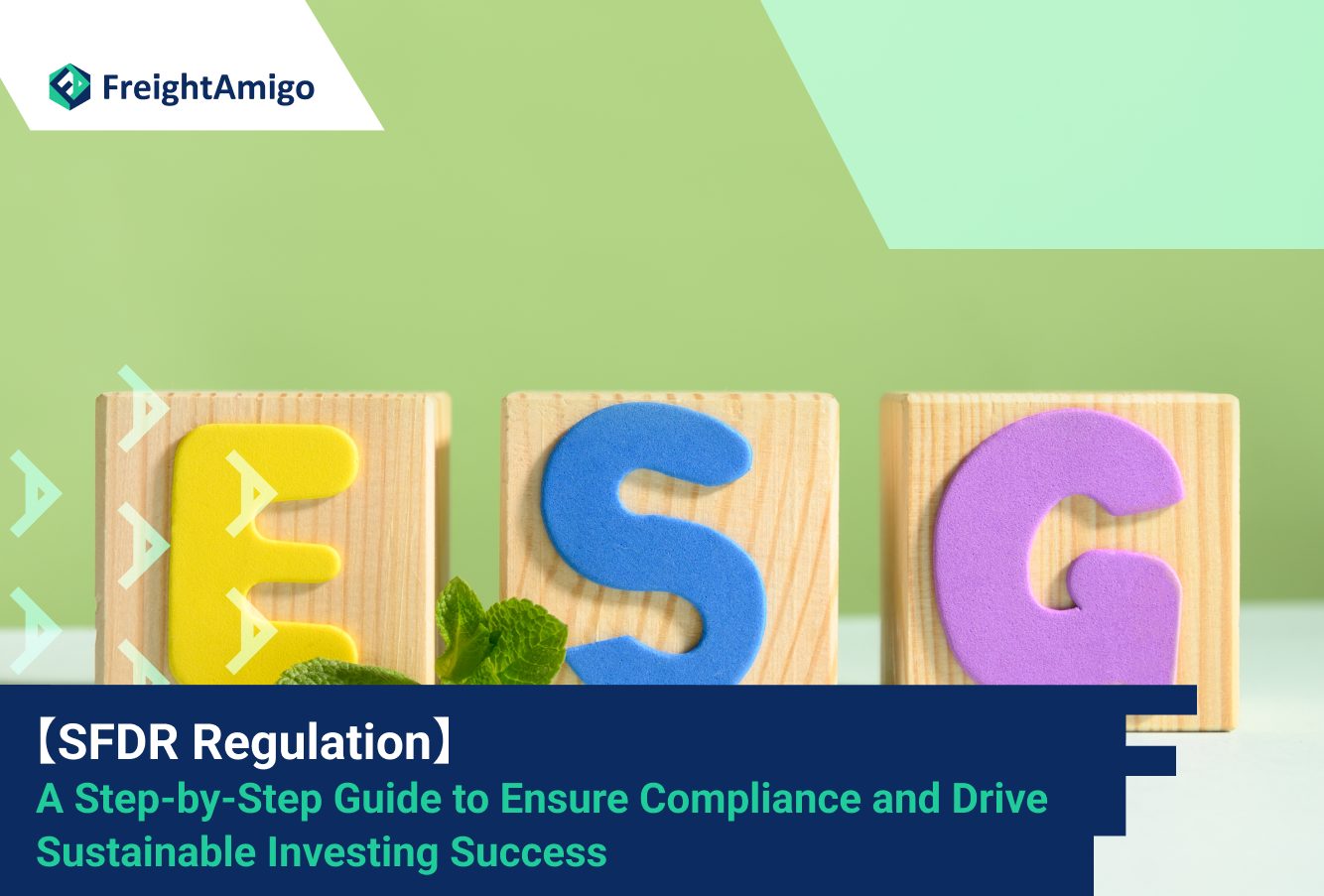What is the SFDR ?
Sustainable Finance Disclosure Regulation | Comprehensive Guide
Author Name: Tiffany Lee – Marketing Analyst at FreightAmigo
Introduction to SFDR Regulation
The SFDR (Sustainable Finance Disclosure Regulation) is a landmark regulation introduced by the European Union (EU) to promote sustainable investing and drive positive environmental and social impact. It sets out a framework for financial market participants and advisors to integrate sustainability considerations into their investment decisions and disclose relevant information to investors. Understanding the goals and principles of SFDR is crucial for both financial institutions and investors looking to navigate the sustainable investing landscape effectively.
SFDR aims to tackle greenwashing and enhance transparency by establishing clear guidelines for sustainable investment products. The regulation requires financial market participants, including asset managers, insurance companies, and pension funds, to disclose how they integrate environmental, social, and governance (ESG) factors into their investment decision-making processes. This disclosure is intended to empower investors to make informed choices based on reliable and comparable information.
Want To Compare The Best Express, Air Freight, Sea Freight, Rail Freight & Trucking Rates So As To Have Better Control On Cost?
Key Requirements and Obligations under SFDR Regulation
To ensure compliance with SFDR, financial market participants must fulfill several key requirements and obligations. Firstly, they need to classify their products into one of three categories: Article 6, Article 8, or Article 9. These categories determine the level of sustainability of the product and the corresponding disclosure obligations.
Article 6 products are those that do not promote environmental or social characteristics, while Article 8 products promote environmental and/or social characteristics. Article 9 products, also known as “dark green” products, have sustainability as their primary objective. Each category has specific disclosure requirements, ranging from basic transparency to more detailed sustainability information and ongoing reporting obligations.
Furthermore, financial market participants must also consider and disclose the adverse impacts of their investment decisions on sustainability factors. This includes assessing and disclosing the impact on climate change, biodiversity, and social issues. The regulation also requires the integration of certain ESG factors into investment decisions, such as the consideration of the carbon footprint of investments.
Step-by-Step Guide to Ensure Compliance with SFDR
Complying with SFDR may seem daunting at first, but with a systematic approach, it can be manageable. Here is a step-by-step guide to help financial market participants ensure compliance:
- Assess Applicability: Determine whether SFDR applies to your organization based on its classification as a financial market participant or advisor. If applicable, identify the specific obligations based on the product categories.
- Evaluate Internal Processes: Review existing investment decision-making processes and identify areas that need to be adjusted or enhanced to incorporate sustainability considerations. This may involve strengthening ESG research capabilities, establishing clear evaluation criteria, or revising investment policies.
- Implement ESG Integration: Integrate ESG factors into investment decision-making processes by considering the environmental and social impact of investments. This could involve developing ESG scoring models, engaging with companies on sustainability issues, or collaborating with external ESG data providers.
- Classify Products: Classify investment products into the appropriate SFDR categories (Article 6, Article 8, or Article 9) based on their sustainability characteristics. This will determine the level of disclosure and reporting obligations.
- Prepare Disclosures: Develop comprehensive and transparent disclosures that align with the SFDR requirements. This includes providing information on how sustainability risks are integrated, the impact of investment decisions on sustainability factors, and any sustainable investment objectives.
- Establish Reporting Mechanisms: Put in place robust reporting mechanisms to ensure ongoing compliance with SFDR. This may involve periodic reporting on sustainability indicators, adverse impacts, and the overall sustainability of investment products.
By following this step-by-step guide, financial market participants can navigate the complexities of SFDR and ensure compliance while driving sustainable investing success.
Conducting an Impact Assessment under SFDR
One of the core requirements of SFDR is the assessment and disclosure of the adverse impacts of investments on sustainability factors. Financial market participants need to conduct a comprehensive impact assessment to identify and quantify these adverse impacts. This assessment should cover a range of sustainability factors, including climate change, biodiversity, and social issues.
To conduct an impact assessment, financial market participants can utilize various tools and methodologies. These may include carbon footprint analysis, water footprint analysis, social impact assessments, and biodiversity assessments. By quantifying the adverse impacts, financial market participants can gain a deeper understanding of the sustainability implications of their investment decisions and make more informed choices.
The impact assessment should be an ongoing process, with regular updates and refinements based on new data and insights. It is important to establish a structured and systematic approach to impact assessment to ensure consistency and comparability across different investment products.
Reporting and Disclosure Requirements under SFDR
SFDR places significant emphasis on transparency and disclosure. Financial market participants must provide clear and accurate information to investors regarding the sustainability characteristics and impacts of their investment products. This information should be easily accessible, comparable, and understandable to enable investors to make informed decisions.
The reporting and disclosure requirements under SFDR include both pre-contractual and periodic disclosures. Pre-contractual disclosures should be provided to potential investors before they make an investment decision. These disclosures should include information on the sustainability objectives, the methodology used to assess sustainability, and any adverse impacts on sustainability factors.
Periodic disclosures should be made on an ongoing basis to existing investors. These disclosures should cover a range of information, including the sustainability indicators used, the results of the impact assessment, and details on how sustainability risks are integrated into the investment decision-making process.
Overcoming Challenges in Implementing SFDR
Implementing SFDR can present challenges for financial market participants due to its complexity and the need for significant organizational change. Some of the key challenges include:
- Data Availability: Access to reliable and consistent ESG data can be a challenge. Financial market participants need to establish robust data collection and verification processes to ensure the accuracy and integrity of the disclosed information.
- Lack of Standardization: SFDR is a new regulation, and there is currently a lack of standardization in terms of methodologies and metrics. Financial market participants may face difficulties in comparing and benchmarking their sustainability performance against peers.
- Resource Constraints: Compliance with SFDR requires dedicated resources and expertise. Smaller financial market participants may face resource constraints in implementing the necessary changes and meeting the reporting and disclosure obligations.
To overcome these challenges, financial market participants can leverage tools and resources provided by industry associations, data providing platforms, and consultants. Collaborating with peers and sharing best practices can also help in navigating the implementation process more effectively.
Benefits of SFDR Compliance for Sustainable Investing Success
While implementing SFDR may require significant effort and resources, it also brings several benefits for financial market participants and investors alike. Some of the key benefits of SFDR compliance include:
- Enhanced Transparency: SFDR promotes transparency by requiring financial market participants to disclose relevant information on sustainability characteristics and impacts. This transparency builds trust and enables investors to make more informed decisions.
- Improved Risk Management: Integrating sustainability considerations into investment processes helps identify and manage ESG risks. This allows financial market participants to better mitigate potential risks and seize opportunities arising from sustainable investing.
- Access to Sustainable Investing Opportunities: SFDR encourages the development of sustainable investment products by setting clear standards and disclosure requirements. This enables investors to access a wider range of sustainable investment opportunities aligned with their preferences and values.
- Alignment with Stakeholder Expectations: SFDR reflects the growing societal and investor demand for sustainable investing. By complying with SFDR, financial market participants demonstrate their commitment to addressing environmental and social challenges, aligning with stakeholder expectations, and contributing to a more sustainable future.
AmiGo Green for Navigating SFDR Regulation
As a 1-stop supply chain finance eMarketPlace, FreightAmigo firmly believes that we have the responsibility to promote green logistics technology in the industry. Through collaboration with stakeholders, we can reduce carbon footprint in the supply chain, strive for sustainable development and attain the vision of a green supply chain.
AmiGo Green helps you quickly and conveniently find the best Green Freight Route Quotation available. Our certified online worldwide CO2 Emissions Calculator covers all modes of transport, including air, sea, courier, trucking and rail freight. Additionally, we offer certified Carbon Offset by Shipment (in kg), as well as digitalized Shipping Documentation. All of the calculations are performed based on the approved European standard for carbon measurement.
Conclusion: Embracing SFDR for a Sustainable Future
The SFDR Regulation represents a significant step forward in promoting sustainable investing and driving positive environmental and social impact. By embracing SFDR, financial market participants can ensure compliance with the regulation while contributing to a more sustainable future.
While implementing SFDR may present challenges, the benefits of compliance, including enhanced transparency, improved risk management, and access to sustainable investment opportunities, make it a worthwhile endeavor. By leveraging tools and resources and collaborating with industry peers, financial market participants can navigate SFDR effectively and contribute to a more sustainable and resilient financial system.
Achieve sustainable development goals for SMEs and businesses with AmiGo Green today!
Read More:
TCFD: The Game-Changer in Climate Reporting for Businesses and Investors
Harnessing the Power of Sustainable Investing: An In-Depth Look at ESG
If you have any inquiries on logistics/supply chain, feel free to contact FreightAmigo now:
Chat with us online | Phone : +852 28121686 | WhatsApp: +852 27467829









































